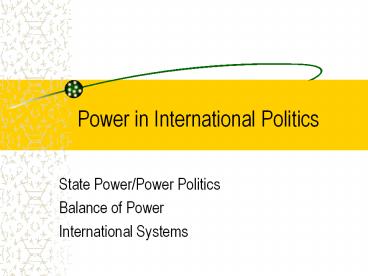Power%20in%20International%20Politics - PowerPoint PPT Presentation
Title:
Power%20in%20International%20Politics
Description:
... International Politics. State Power/Power Politics. Balance ... Neo-realism (K. Waltz) makes int'l structure the key explanation of all international politics. ... – PowerPoint PPT presentation
Number of Views:313
Avg rating:3.0/5.0
Title: Power%20in%20International%20Politics
1
Power in International Politics
- State Power/Power Politics
- Balance of Power
- International Systems
2
Key Concepts
- Anarchy and self-help.
- The security dilemma.
- Security dilemma within a society of states.
- Power Politics whereas power is unequally
distributed, each state must provide its own
security, and whereas one states security is
anothers threat, states continually vie for
power to be secure. - PP includes diplomacy, alliance, BoP, War, Peace,
even IL and IO. Primacy is Power.
3
Types of State Power
- The form of PP changes, but the nature of state
relations remains the same. - Great Powers have five features. (Roman,
Napoleonic, British empires, USA/USSR post 1945). - Middle Powers GPs value its resources, strategic
position and military value added. (Regional MPs
France, Indonesia). - Small Powers do not affect BoP (Netherlands),
are most insecure, can be flashpoints (Israel).
4
Nature of GP Power Politics
- Status Quo vs. Revolutionary GPs.
- Tools national power, alliances, diplomacy.
(Classical vs. Cold War Structural Realism K.
Waltz) - GPs may seek concert for world domination.
- GP may seek universal empire.
- Former GPs may be submerged in power structure of
supplanter Holland-England, A-H Empire-Germany,
UK-US, ?USA-China?
5
End of Part I
6
Balance of Power various meanings
- Historical/descriptive assessment of power.
- BoP not as conscious state policy but as a
function of systems equilibrium. - Grotian (Liberal) Balance enlightened
self-interest makes near equilibrium a founding
principle of the society of states (eg Concert
of Europe), used to limit conflict, grant
compensation, and avert hegemony, eventually
overcome war. - Machiavellian Balance BoP is inevitable. States
only have permanent interests maintaining the
scales in their favour. BoP is inherently
unstable. - Immanuel Kant reject the power trap, both as
practice and as prescription.
7
Realist Rules for BoP
- Always increase capabilities, but choose
diplomacy over war. (Morton Kaplan) - War rather than a loss in capabilities.
- Oppose preponderance by one GP.
- Avoid uncertainty of eliminating other GPs
(Versailles, Gulf 1991) or allowing a new order
not based on Power Politics.
8
Preponderance rather than Balance
- Preponderance of Power school of thought.
(balances are unstable, benevolent hegemony is
better Cold War, war is likely when hegemon
declines or challenger closes the gap). - Hegemonic stability theory hegemon underwrites
rules of trade and diplomacy which creates
stability - Declining hegemons/stability causes war or
systems change
9
International Systems
- The type of configuration of power in a time and
geographical framework. - Holstis five IS aspects boundary, units,
interaction, norms, structure. - Structure number of GPs, nature of their power,
alliances. - Neo-realism (K. Waltz) makes intl structure the
key explanation of all international politics.
10
Types of Structure
- Unipolar (tether pole). National or bloc power
Roman Empire. - Multipolar (merry-go-round). National power and
alliances. (1648-1814 Europe), South Asia today. - Bipolar (see-saw). National power and alliance
blocs. Triple Alliance Ge, It, A-H, 1882) and
Triple Entente Eng-Fr-Rus. 1907, and Cold War. - Each has its own type of dominant security
problem challenger/assimilation shifting
alliances escalation/zero-sum conflict
11
Conflict Potential and Risk calculation
- Deutsch and Singer definition of stability (no
dominant, all GPs remain, no large-scale war) - Multipolar potentially many conflicts, but also
countervailing alliances and BoP holder. - Bipolar potential zero-sum and high risk of
escalation, but more political control.(offset by
ideology and MAD) - Structure of IS is also contextual rules of war
and diplomacy change.
12
Todays International System
- Boundaries global strong points
- Units democracies vs. the rest
- Interaction eco, pol, mil, cult.
- Structure unipolar and multipolar mixed.
13
Complicating Factors
- Non-state actors and intrastate wars.
- Proliferation of Nuclear Weapons and Weapons of
Mass Destruction (WMD). - Trade blocs vs. WTO
- USA is not a traditional empire. It is a mixture
of primus inter pares, benevolent hegemon,
globocop, and traditional GP. - Triumph of Liberalism and instant communication
challenges legitimacy of national interest and
possibility of limited war.
14
Conclusion
- Does the end of territorial aggrandizement mean
the end of GP Power Politics? - Does the presence of Nuclear Weapons mean the end
of GP Power Politics? - Does Globalization?
- Can regional or global organization (NATO/UN)
prevent/overcome GP politics? - Each GP has its own power and normative context.
- Todays Power Politics The Role of one Hyper
Power.
15
Future System Watch
- Will a multipolar MAD be as stable as the Cold
War MAD? - Will missile defence replace deterrence?
- Will WMD replace Nuclear Weapons?
- Will rigid trade blocs emerge from globalization?
- Will the state system weaken from quasi states
and global economics? - Will civilization/religion clashes replace
inter-state war?































